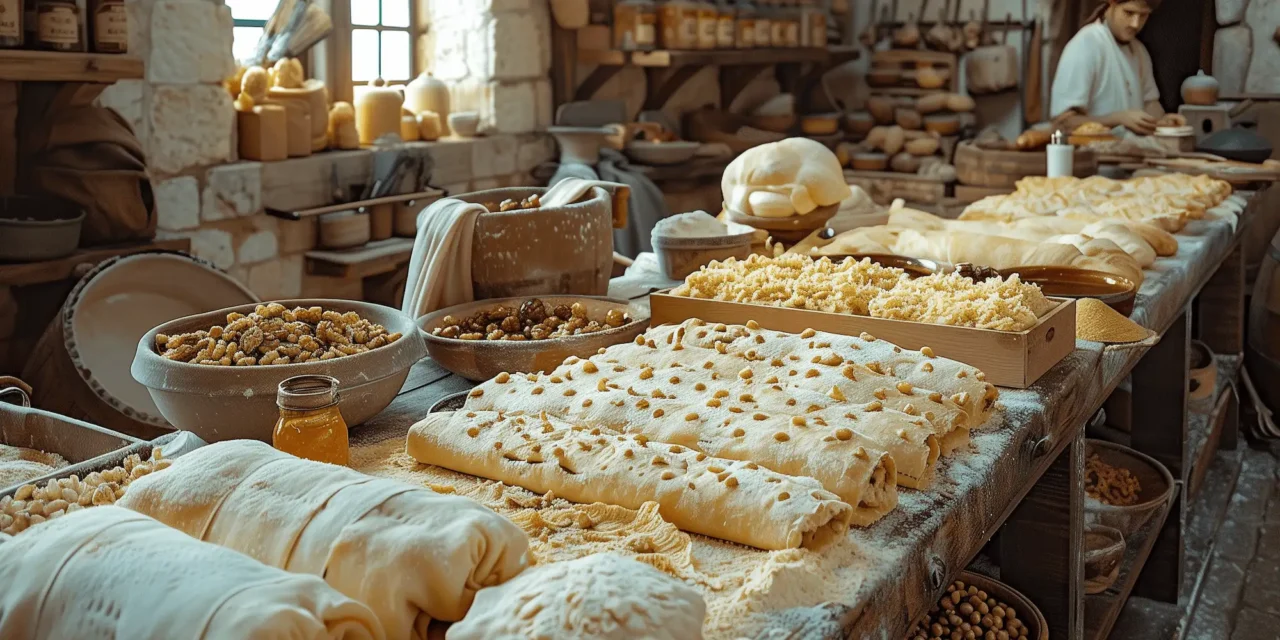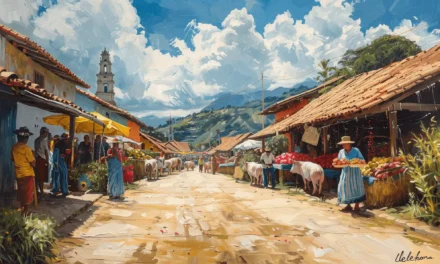Puff pastries have been a delicacy that some would say is crucial in cafes, tea houses, and bakeries, accompanying us for a long time. Yet we know too little about puff pastry’s origins and how it gained its popularity.
Puff pastry is a type of dough that is made from flour, water, salt, and butter. The dough is rolled out and then folded several times to create layers. The dough is then refrigerated and later rolled out and cut into shapes. The dough is then baked at a high temperature, which causes the water in the dough to turn to steam, creating the signature puffiness of the pastry 1.
Puff pastry gained popularity in France in the 17th century, known as pate feuilletée. It wasn’t until the 18th century that puff pastry became known as we know it today, with the French chef Antoine Careme calling it pate a choux, or “cream pastry.”
Puff pastry has a long and storied history, dating all the way back to the European Middle Ages. Back then, people didn’t have access to the same kinds of preservatives we have today, so they had to get creative with their food storage. They came up with different doughs and pastes, all of which were designed to keep food fresh for longer periods. None of these recipes are quite like the puff pastry we know and love today, but they laid the groundwork for this delicious treat.

Puff pastry is a lot like traditional recipes from the Middle East and Central Asia. The primary ingredient in puff pastry is the same as the primary ingredient in phyllo dough. Although puff pastry and phyllo dough are not the same, they share similarities that are descendants of Arabian and Turkish cultures.
Puff pastries have been around for centuries, and no one knows exactly who invented them. However, some food historians believe that European cooks may have developed puff paste as a result of the well-known recipes with the influence of Arabian and Ottoman cultures that arrived with international trade and invasions.
The origin of Baklava: A mystery unraveled
This delectable dish, made of chopped nuts sandwiched between flaky layers of phyllo dough, smothered in butter, and drenched in syrup or honey, was the favorite of sultans and aristocrats from the Middle East, Central Asia, and the Maghreb. Different puff pastry recipes may be similar to this traditional dessert, but they’ll never quite measure up.
Baklava is a delicious, old pastry that’s been around for centuries! Different countries and societies claim to be the original creators of Baklava, but its true origins are still unknown. Baklava has been associated with the Assyrians, Persians, Byzantines, and Muslims. Still, most evidence today points to it being created in Anatolia by the Turks and Ottomans. There are many different recipes for Baklava, depending on what ingredients are available in the region 2.
Anatolia is basically one big nut-fest, and that’s not a bad thing! Depending on where you are in Anatolia, you’ll find all sorts of delicious nuts in pastries. In Southeast Anatolia, you’ve got pistachio nuts. In the Black Sea region, they go for hazelnuts. In central Anatolia, they’re all about the walnuts. And on the Aegean shores, they use almonds3.
You could say that the different tribes in Anatolia were really dough-ing their best! They had an abundance of wheat and dairy products, so they were able to work on different kinds of dough. Anatolia is overrun with wheat and dairy, so the tribes there have become quite expert at working with different doughs. In fact, most of the doughs used in Baklava and other pastries were first developed in Anatolia 3.
Baklava is a delicious pastry that is popular in many parts of the world. It is made with layers of phyllo dough, filled with nuts, and sweetened with syrup or honey. The origin of Baklava is a bit of a mystery, but it is thought to have originated in the Middle East. It is possible that the technique for making Baklava was brought to the Middle East by the Muslim conquests, the Silk Road, or the Ottoman Empire Expansion. We have similar recipes all over the place 3.

Layers of History: The Evolution of Borek Recipes
Borek is a type of filled pastry or pie in Turkish cuisine, made of dough rolled flat and either wrapped around a filling or folded into a triangular, half-moon, or square shape. It is usually based on a yeast-raised dough, although some versions are based on phyllo pastry. Borek can be made with cheese, meat, spinach, potatoes, or rice 4.
Since the 7th century, the predecessors of Borek were consumed by nomads, travelers, explorers, farmers, shepherds, and traders in Central Asia. These recipes used to be cooked on a saj (a flat-iron griddle), suspended over an open fire, or placed on hot stones. The main ingredients were available on the steppe or bought in the local markets 4.
Borek’s origins are as clear as mud. We have only a few pieces of information before the half of the 12th century. However, it does provide us with a few clues about where and when it first appeared. Borek comes from the Byzantine (395 – 1453) plakous: A flat cake that descended from the Roman (27 BC – 395 AD) placenta, consisting of two sheets of pastry stuffed with honey and cheese or chopped nuts 4.
If you want to make a Borek recipe, you’ll need to get your hands on some yufka dough. This traditional flatbread from Turkey is super thin, so you’ll need to roll it out or place it in layers. The goal is to create a layered effect with the sheets of dough 5.
It’s a mystery why this technique became Borek’s thing. It’s almost like a pastry divided into layers, seasoned with spices, and filled with a mix of ingredients that was more practical and palatable for people. Once aristocrats and royalty adopted the dish from the Ottoman Empire, the technique to obtain a thinner and more refined paste was on the way.
Who knows how long phyllo dough has been around? Probably since the beginning of time! But the first mention of it in history was in the 1500s, in Istanbul, during the Ottoman Empire, sometimes called Golden Age. Although phyllo dough might have been invented even earlier, we don’t have any information about it from before that time 1.
| Puff Paste | Phyllo Dough |
| Mix wheat flour with cold water. | Mix wheat flour with water and a little bit of salt. |
| 50 parts of water for 100 parts of flour. | 40 parts of water for 100 parts of flour. |
| Shape the dough like a square. | Roll out the dough and shape it like a thin disc. |
| Work with the fat (butter) at a low temperature (15ºC maximum) until having a similar consistency to the paste. | No substantial amount of fat is added to the dough. to prevent cracking the dough, brush with oil or melted fat (butter). |
| Shape the fat with a similar shape to the paste. | No substantial amount of fat is added to the dough. |
| Flatten the fat over the dough. | It is very important to brush the dough with oil or melted fat (butter). |
| Fold and roll out the paste several times. | Sprinkle with flour or starch and roll out again. |
| 729 layers of dough and 728 layers of fat. | A thin dough with no layers that can be used in sheets for a recipe. |
| The thickness of 6mm. | The thickness of 0,1mm per unit. |
| Phyllo Dough | Yufka |
| Mix wheat flour with water and a little bit of salt. | Mix wheat flour with water, olive oil, and salt. |
| 40 parts of water for 100 parts of flour. | 65 parts of water for 100 parts of flour. |
| Roll out the dough and shape it like a thin disc. | Roll out the dough and shape it like a thin disc. |
| No substantial amount of fat is added to the dough. to prevent cracking the dough, brush with oil or melted fat (butter). | Depending on the recipe or use for yufka, the amount of olive oil or fat can change. |
| No substantial amount of fat is added to the dough. | Some recipes of yufka do not have oil or fat. |
| Brushing the dough with oil or melted fat (butter) is very important. | Depending on the recipe, the type of oil or fat used can change. |
| Sprinkle with flour or starch and roll out again. | Stretch the dough and roll out until obtaining the desired thickness. |
| A thin dough with no layers can be used in sheets for a recipe. | A thin dough for a flatbread that can be used alone or in sheets for a recipe. |
| The thickness of 0,1mm per unit. | The thickness can be similar to paper (0.2 mm) (with a diameter of 50 to 75cm). |
Medieval Meals: Why Puff Pastry Was Used to Preserve Meat
Small particles? Delicate textures? We’re talking about the dainty, delicious world of pastry here! This comes from the ancient Greek word for “pastry,” which also gave us the French patê, the Spanish pasta, and pastel. In the Middle Ages, patê was used to describe a minced meat recipe that was either inside or wrapped in bread dough 1.
Just like in the Middle East, Central Asia, and the Maghreb, different recipes for Puff Pastry emerged in Europe during the Roman period (27 BC – 395 AD). According to McGee (2011) 1, the primary purpose of most of these recipes was to preserve meat by enclosing it in the dough, which prevented the development of bacteria and allowed people to keep the meat for days. We will find a similar pattern if we analyze the first historical references to Puff Pastry in Europe.
The first known recipe of modern puff pastry (using butter or lard) appears in the Spanish recipe book “Libro del Arte de Cozina” (Book on the Art of Cooking) written by Domingo Hernández de Maceras and published in 1607. Hernández de Maceras was the head cook in one of the schools from the University of Salamanca. He distinguished between filled puff pastry recipes and pastry tarts and even mentioned leavened preparations (Hernández de Maceras, 1607 – 2011, pp. 27-28)6. Puff pastry use was widespread in Spain by the 17th century.
One of the oldest English recipes for puff pastry was written by Gervase Markham in “The English Housewife” (1615):
“110 Of puff paste”.
“Now for the making of puff paste of the best kind, you shall take the finest wheat flour after it bath been a little baked in a pot in the oven, and blend it well with eggs, whites and yolks all together, after the paste is well kneaded, roll out a part thereof as thin as you please, and then spread cold sweet butter over the same, then upon the same butter roll another leaf of the paste as before; and spread it with butter also; and thus roll leaf upon leaf with butter between till it be as thick as you think good and with it either cover any baked meat, or make paste for venison, Florentine, tart or what dish else you please and so bake it. There be some that to this paste use sugar, but it is certain it will hinder the rising thereof; and therefore, when your puffed paste is baked, you shall dissolve sugar into rose-water, and drop it into the paste as much as it will by any means receive, and then set it a little while in the oven after and it will be sweet enough” (Markham & Best, 1986, p. 98) (McGee, 2011, pág. 599) 7 1.
Hannah Glasse, The Art of Cookery made Plain & Easy, 1747, p.75
Puff-Paste (Puff-paſte).
Take a quarter of a Peck of Flour, rub fine half a Pound of Butter, a little Salt, make it up into a light Paste with cold Water, just stiff enough to work it well up; then roll it out, and stick pieces of butter all over, and strew a little Flour; roll it up, and roll it out again; and so do nine or ten times, till you have rolled in a Pound and half of Butter. This Crust is mostly used for all Sorts of Pies (Muusers, 2019) (Glasse & Evans, 2010–2015, p. 145) 8 9.
The London Art of Cookery, 1783, p.142
Puff paste is made thus. Rub a pound of butter very fine into a quarter of a peck of flour. Make it up into a light paste with cold water, just stiff enough to work it. Then roll it out about the thickness of a crown-piece, and put a layer of butter all over. Sprinkle on a little flour, double it up, and roll it out again. Double it, and roll it out seven or eight times, when it will be fit for all sorts of pies and tarts that require a puff-paste (Muusers, 2019) (Farley, 1783, p. 142)10 11.
If we take a deep dive into the history of puff pastry, we can see that the earliest references to it come from Europe. Puff pastry was traditionally used as dough for pies, tarts, pastries, and other baked goods. The technique for making puff pastry wasn’t standardized back then like it is now, but recipes indicated that the dough should be rolled out multiple times. These recipes also advised the reader to adjust the sweetness or saltiness of the dough as necessary.
The Evolution of the Apple Strudel
Ottoman Empire’s occupation of Hungary and other territories in Europe resulted in the adoption of phyllo dough and puff pastries. The recipes for “retes” in Hungaryrates and “strudel” in Austria and Germany are the legacy of this historical period 12 13.
The oldest known strudel recipe is from 1697 that survives today in a handwritten cookbook in the Vienna Town Hall Library. The dessert gained popularity in the 18th century, particularly throughout the Austro-Hungarian Empire during the expansion of the Habsburg Empire14 13.
Baklava is of Turkish origin, and Apple Strudel is of Austrian origin. However, the Strudel is more likely a collaboration of different cultures, contributing to its creation. The Apfelstrudel has a lot of similarities with the Turkish baklava. They are both pastries filled with fruit and nuts and made with dough rolled out very thin 15 13.
- McGee, H. (2011). La Cocina y Los Alimentos (Sexta ed.). (J. M. Ibeas, Trad.) Barcelona, España: Debate.[↩][↩][↩][↩][↩]
- Geerts, E. (2013, October). What Is Baklava and Where To Find the Best Baklava in Istanbul? Retrieved from Witt Hotels magazine: https://web.archive.org/web/20131004231854/http://www.wittistanbul.com/magazine/what-is-baklava-and-where-to-find-the-best-baklava-in-istanbul/[↩]
- Akkaya, A., & Koc, B. (2017, August 05). Past, Present and Tomorrow of Baklava. Retrieved from International Rural Tourism and Development Journal: https://www.researchgate.net/publication/324107511_Past_Present_and_Tomorrow_of_Baklava[↩][↩][↩]
- Lee, A. (2019, September 9). A History of Börek. Retrieved from History Today Ltd.: https://www.historytoday.com/archive/historians-cookbook/history-borek[↩][↩][↩]
- Muusers, C. (2019, November 27). Arabian pasties. Retrieved from COQUINARIA: https://coquinaria.nl/en/arabian-pasties/[↩]
- Hernández de Maceras, D. (1607 – 2011). Libro del Arte de Cozina. Salamanca: University of Salamanca.[↩]
- Markham, G., & Best, M. R. (1986). The English Housewife. Kingston: McGill-Queen’s University Press.[↩]
- .Muusers, C. (2019, November 29). Puff Pastry according to Hannah Glasse and John Farley. Retrieved from COQUINARIA: https://coquinaria.nl/en/glasse-puff-pastry/#recept[↩]
- Glasse, H., & Evans, D. L. (2010–2015). Celtnet Hannah Glasse Recipes for Pies, Chapter 8. Retrieved from Hannah Glasse’s 1747 volume, The Art of Cookery Made Plain and Easy: http://www.celtnet.org.uk/recipes/glasse-of-pies-08.php[↩]
- Muusers, C. (2019, November 29). Puff Pastry according to Hannah Glasse and John Farley. Retrieved from COQUINARIA: https://coquinaria.nl/en/glasse-puff-pastry/#recept[↩]
- Farley, J. (1783). The London Art of Cookery, and Housekeeper’s Complete Assistant: On a New Plan. Retrieved from The Google Books Digital Content Store: https://books.google.nl/books?id=Gt5QAQAAIAAJ&dq=editions%3AbIFmoawVnf8C&hl=nl&pg=PP1#v=onepage&q=editions:bIFmoawVnf8C&f=false[↩]
- Stadt Wien, Rathaus. (2019). History of Viennese coffee house culture. Retrieved from City of Vienna:
https://www.wien.gv.at/english/culture-history/viennese-coffee-culture.html#:~:text=1683%20%2D%20the%20beginning%20of%20Viennese%20coffee%20house%20culture&text=A%20street%20in%20Vienna’s%204th,by%20the%20Armenian%20spy%20Diodato[↩] - Corbin & King Restaurant Group Limited. (2022). A Brief History of the Apple Strudel. Retrieved from The Delaunay: https://www.thedelaunay.com/our-news/a-brief-history-of-the-apple-strudel/[↩][↩][↩]
- Stadt Wien, Rathaus. (2019). History of Viennese coffee house culture. Retrieved from City of Vienna: https://www.wien.gv.at/english/culture-history/viennese-coffee-culture.html#:~:text=1683%20%2D%20the%20beginning%20of%20Viennese%20coffee%20house%20culture&text=A%20street%20in%20Vienna’s%204th,by%20the%20Armenian%20spy%20Diodato[↩]
- Kunz, F. (2011, August). Die Strudelfamilie – eine Wiener Mehlspeisendynastie mit orientalisch-europäischem Stammbaum, in “backwaren aktuell. Retrieved from backwaren aktuell: http://www.wissensforum-backwaren.de/files/backwaren_aktuell_02_11.pdf[↩]




